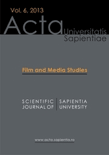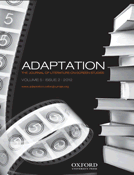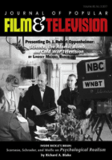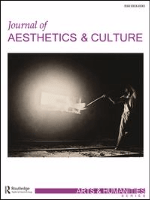
Nauka Televideniya-The Art and Science of Television
Scope & Guideline
Illuminating the Cultural Impact of the Television Medium
Introduction
Aims and Scopes
- Interdisciplinary Media Studies:
The journal focuses on the intersection of various disciplines including film studies, cultural studies, sociology, and technology, providing a rich analysis of how these fields interact within the realm of television and media. - Cultural Representation and Mythology:
A consistent theme is the exploration of cultural representations and mythological narratives, particularly in how they manifest in contemporary media, reflecting societal values and collective consciousness. - Historical and Contemporary Analysis:
The journal publishes works that analyze both historical and contemporary media practices, examining the evolution of genres, styles, and audience reception over time. - Technological Impact on Media:
There is a strong emphasis on the impact of digital technology on media production and consumption, including studies on digital devices, social media influence, and the transformation of traditional media formats. - Posthumanism and Media Art:
The journal explores posthumanistic perspectives in media, examining how technology reshapes our understanding of the body, identity, and narrative in film and television. - Audience Studies and Psychological Impacts:
Research often delves into audience reception studies, exploring the psychological and social effects of media consumption on individuals and communities.
Trending and Emerging
- Digital Media and Technology:
The rapid evolution of digital technologies and their integration into everyday life is a major theme, with studies examining the implications of digital devices on media consumption and societal behavior. - Posthumanism and Cyborg Narratives:
There is a growing trend towards exploring posthumanism and cyborg narratives in media, reflecting on how technology influences identity and representation in contemporary storytelling. - Infotainment and Media Ethics:
Research on infotainment, particularly in news media, has gained traction, focusing on the ethical implications of blending information with entertainment in the digital age. - Environmental Narratives in Media:
Emerging themes related to environmental issues and ecological narratives are becoming prominent, as media increasingly reflects societal concerns about climate change and ecological crises. - Transmedia Storytelling and Audience Engagement:
Scholarly interest in transmedia storytelling is on the rise, exploring how narratives extend across multiple platforms and engage audiences in new interactive ways.
Declining or Waning
- Traditional Historical Cinema:
There is a noticeable decrease in studies focused on traditional historical cinema, particularly as newer forms of media and storytelling methods gain prominence in academic discourse. - Soviet Cinema Studies:
While once a focal point, research specifically centered on Soviet cinema appears to be diminishing, likely overshadowed by broader inquiries into global cinema and contemporary media practices. - Gender Dominance in TV Content:
Although gender representation remains a critical topic, specific studies on gender dominance in television content have seen a reduction, as the discourse shifts towards more intersectional and nuanced analyses. - Local Television Practices:
The focus on localized television practices, particularly in non-Western contexts, seems to be waning, possibly due to a growing interest in global media trends and transnational influences. - Documentary Forms:
Research exploring traditional documentary forms is less frequent, as scholars increasingly investigate hybrid genres and the evolving nature of documentary storytelling.
Similar Journals

Acta Universitatis Sapientiae-Film and Media Studies
Illuminating Emerging Trends in Film and Media PracticesActa Universitatis Sapientiae-Film and Media Studies is a distinguished journal dedicated to the exploration of film and media within the broader context of cultural studies. Published by SCIENDO, this journal has been an essential resource for researchers, professionals, and students since it adopted an Open Access model in 2013, facilitating worldwide accessibility to cutting-edge scholarship. With its ISSN 2065-5924 and E-ISSN 2066-7779, Acta Universitatis Sapientiae aims to publish high-quality, peer-reviewed articles that promote innovative research and critical discourse in film and media studies. Located in Warsaw, Poland, and contributing to the international academic community, this journal provides a platform for interdisciplinary dialogue and the examination of emerging trends in media practices, theories, and technologies. By encouraging diverse perspectives, it not only enriches the academic landscape but also nurtures the next generation of scholars in this dynamic field.

Adaptation-The Journal of Literature on Screen Studies
Transforming Texts into Visual Narratives.Adaptation: The Journal of Literature on Screen Studies, published by Oxford University Press, stands at the forefront of interdisciplinary scholarship, blending the realms of literature, visual arts, and performing arts. This esteemed journal addresses the evolving relationship between literature and its adaptation into various screen formats, providing a vital platform for researchers, professionals, and students interested in the adaptation process across different media. With a commendable 2023 impact factor reflected by its recognition in the Q1 quartile categories for Literature and Literary Theory as well as Visual Arts and Performing Arts, it ranks in the top tiers of its field, showcasing its influence and reach. The journal is dedicated to exploring theoretical and practical approaches to adaptation, ensuring that voices from diverse perspectives are heard. Although it operates under traditional access models, the insights offered in its publications are invaluable for those looking to deepen their understanding of how literature translates into screen narratives. With coverage spanning from 2010 to 2024, Adaptation continues to be a pivotal reference point for innovative scholarship and critical discourse.

JOURNAL OF POPULAR FILM AND TELEVISION
Celebrating the Art of Storytelling in Popular Media.JOURNAL OF POPULAR FILM AND TELEVISION, published by Routledge Journals, Taylor & Francis Ltd, stands as a significant platform for academic discourse in the realms of cultural studies, visual arts, and performing arts. With its ISSN: 0195-6051 and an evolving digital presence indicated by its E-ISSN: 1930-6458, the journal has carved out a respected niche since its inception in 1978, continuing to contribute to scholarly discussions through 2024. Its impact within the academic community is underscored by a Q3 ranking in Cultural Studies and a Q2 ranking in Visual Arts and Performing Arts for 2023, highlighting its relevance across diverse fields. Notably, with a Scopus ranking placing it in the 74th percentile among visual arts and performing arts journals, it serves as an essential reference point for researchers, professionals, and students committed to the critical examination of film and television. Although not an open-access journal, it provides valuable insights and analysis that enrich understanding of popular media's impact on society. The journal's location in the United States, with a headquarters in Abingdon, England, further affirms its international scope and influence.

Journal of Aesthetics & Culture
Documenting the Vibrancy of Visual and Performing ArtsJournal of Aesthetics & Culture, published by TAYLOR & FRANCIS LTD, is a prestigious Open Access journal that has been serving the academic community since its inception in 2009. Based in the United Kingdom, this journal aims to explore, document, and critically engage with themes in Cultural Studies, Philosophy, and the Visual and Performing Arts. Notable for its impact, the journal holds a Q3 ranking in Cultural Studies and Philosophy, and a Q2 ranking in Visual Arts and Performing Arts as of 2023. With its Scopus rankings placing it within the top 17% of Visual Arts and Performing Arts journals and top 31% in Philosophy, it stands as a vital resource for researchers and practitioners alike. Covering a broad range of contemporary issues and inviting innovative perspectives, the Journal of Aesthetics & Culture plays a crucial role in shaping critical discourse within its fields and fostering an understanding of the intricate interplay between aesthetics and societal contexts.

Communication & Society-Spain
Navigating the Complexities of Society Through CommunicationCommunication & Society-Spain, published by Universidad de Navarra, is an esteemed open access journal dedicated to advancing scholarship in the dynamic fields of communication and cultural studies. Since its inception in 1988, the journal has maintained a commitment to disseminating high-quality research that engages with contemporary issues and contributes to the evolving discourse around communication theories and practices. With a commendable Q1 ranking in both Communication and Cultural Studies categories, it stands as a prominent source for researchers and professionals alike, reflecting its robust presence in the academic community—evidenced by its Scopus rankings placing it in the top percentiles within both fields. The journal's scope encompasses diverse perspectives and methodologies, thereby fostering interdisciplinary dialogue essential for understanding the complexities of communication in society. With a publication history that spans from 2010 to 2024 and a ranking of #87 out of 1304 in Cultural Studies, our commitment to open access ensures that impactful research is readily available to all, promoting further scholarly engagement and innovation.

Doxa Comunicacion
Bridging theory and practice in communication sciences.Doxa Comunicación is a prominent open-access journal dedicated to advancing the field of communication studies, published by Universidad San Pablo CEU, under the Faculty of Humanities and Communication Sciences. Established in 2003, this journal has gained recognition for its commitment to disseminating high-quality research and thought-provoking articles, fostering a vibrant academic community. With an ISSN of 1696-019X and an E-ISSN of 2386-3978, Doxa Comunicación occupies a vital niche in the academic landscape of Spain, contributing to both national and international discourses. In the 2023 rankings, it is categorized in the Q3 quartile within the fields of Communication and Social Sciences (miscellaneous), reflecting its competitive standing among peer publications. The journal's diverse scope, including contemporary communication theories and practices, ensures relevance for researchers, professionals, and students alike. With a Scopus rank of #333 in Social Sciences (miscellaneous) and #291 in Communication, Doxa Comunicación serves as an essential platform for innovative research that addresses the complex challenges of modern communication in a rapidly evolving society.

Metro
Exploring contemporary issues in teaching methodologies.Metro is a prominent journal published by Australian Teachers Media Inc, dedicated to advancing the field of education through scholarly research and innovative practices. With a focus on contemporary issues in pedagogy and teaching methodologies, Metro aims to bridge the gap between theory and practice, providing valuable insights for educators, policymakers, and researchers alike. Although the journal does not currently offer Open Access, it continues to uphold rigor and excellence in academic publishing, ensuring that each issue contributes significantly to its readership. Nestled in Australia, Metro fosters a community of educators eager to engage with cutting-edge research that informs effective teaching strategies and educational frameworks. By tackling pressing educational challenges and promoting interdisciplinary dialogue, Metro serves as an essential resource for anyone invested in the transformative power of education.

Critical Studies in Television
Transforming Understanding of Television's InfluenceCritical Studies in Television is a leading academic journal published by SAGE Publications Ltd, dedicated to exploring the intricate dimensions of television within the fields of Communication and Cultural Studies. Since its inception, this journal has become an essential resource for researchers, professionals, and students alike, particularly as it navigates the evolving landscape of television studies from 2014 to 2024. With an impressive impact factor, the journal achieved notable rankings in 2023: it is positioned in the Q2 quartile for Communications and the Q1 quartile for Cultural Studies. Recognized by Scopus with a rank of #160 in Cultural Studies and #193 in Communication, it reflects its growing influence and relevance in these academic arenas. While currently not available through an Open Access model, readers are encouraged to engage with its diverse and critical contributions that foster a deep understanding of television’s role in contemporary culture.

Transnational Screens
Bridging Cultures Through the Lens of Contemporary MediaTransnational Screens is a premier academic journal published by Taylor & Francis Ltd, focusing on the dynamic intersections of visual arts, performing arts, and communication in a globalized context. Since its inception, the journal has garnered significant recognition, featuring in the Q1 category for Visual Arts and Performing Arts and Q3 for Communication as of 2023, reflecting its influential contributions to these fields. With a Scopus ranking placing it in the 78th percentile in Visual Arts and Performing Arts, this journal serves as a vital platform for researchers, professionals, and students aiming to explore the implications of transnational narratives in contemporary media and artistic practices. The journal is accessible to a diverse readership and promotes open dialogue through its commitment to publishing innovative and interdisciplinary research from 2020 to 2024. As a key resource for understanding the complexities of transnational screens, it invites submissions that push the boundaries of traditional scholarship and engage with pressing global issues through the lens of the visual and performing arts.

Connectist-Istanbul University Journal of Communication Sciences
Fostering Interdisciplinary Connections in Media StudiesConnectist-Istanbul University Journal of Communication Sciences is a distinguished academic publication under the auspices of Istanbul University, Faculty of Communication, dedicated to advancing the field of communication studies. Since its inception, this Open Access journal has facilitated the dissemination of groundbreaking research and innovative methodologies, particularly since it embraced an open access model in 2017, promoting wider accessibility and engagement. As a pivotal resource for researchers, practitioners, and students alike, Connectist fosters interdisciplinary dialogue, exploring contemporary issues in communication, media studies, and related disciplines. With a commitment to rigorous peer review and scholarly excellence, the journal serves as an essential platform for cutting-edge insights and developments in communication sciences, thereby contributing significantly to the academic community and beyond.